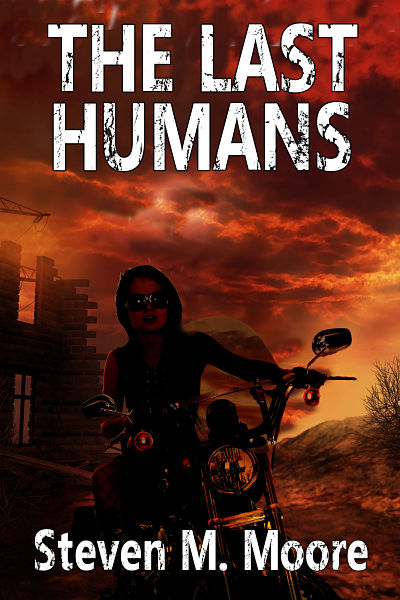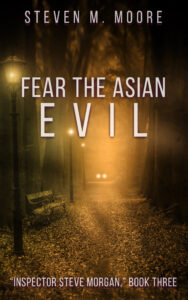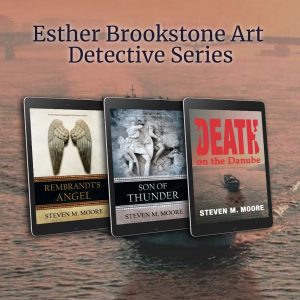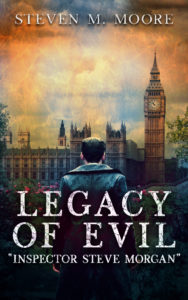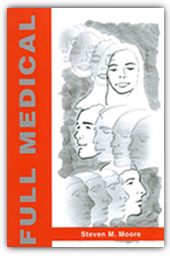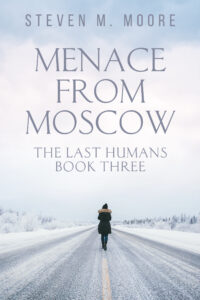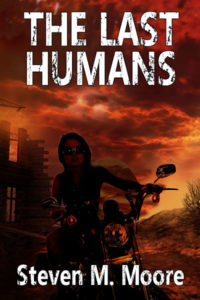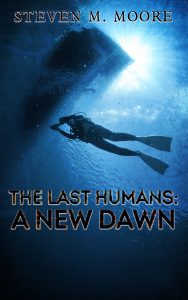Rogue Planet, a romantic sci-fi thriller…
October 16th, 2024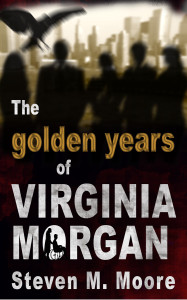 I call some of my novels “bridge books”: They offer readers a span that takes them from one series to another like the GW bridge connects NJ and Manhattan. Sometimes new series intervene, though. There’s no bridge from the “Detectives Chen & Castilblanco” series to the “Esther Brookstone Art Detective” series nor from the latter series to the “Inspector Steve Morgan” trilogy—in a sense, there should be because these are all big series. (Esther appears in “Chen & Castilblanco” and Steve in “Esther Brookstone,” the first more a cameo than the second, which covers Morgan’s transfer from Scotland Yard to Bristol PD.) But The Golden Years of Virginia Morgan is a bridge novel, originally from “Chen & Castilblanco” to the “Clones & Mutants” trilogy and now from “Steve Morgan” to “Clones & Mutants”; and Soldiers of God is a bridge from “Clones & Mutants” to the “Chaos Chronicles,” a trilogy (now available as a bundled ebook).
I call some of my novels “bridge books”: They offer readers a span that takes them from one series to another like the GW bridge connects NJ and Manhattan. Sometimes new series intervene, though. There’s no bridge from the “Detectives Chen & Castilblanco” series to the “Esther Brookstone Art Detective” series nor from the latter series to the “Inspector Steve Morgan” trilogy—in a sense, there should be because these are all big series. (Esther appears in “Chen & Castilblanco” and Steve in “Esther Brookstone,” the first more a cameo than the second, which covers Morgan’s transfer from Scotland Yard to Bristol PD.) But The Golden Years of Virginia Morgan is a bridge novel, originally from “Chen & Castilblanco” to the “Clones & Mutants” trilogy and now from “Steve Morgan” to “Clones & Mutants”; and Soldiers of God is a bridge from “Clones & Mutants” to the “Chaos Chronicles,” a trilogy (now available as a bundled ebook).
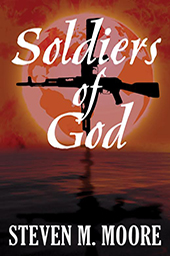 Rogue Planet, however, might seem like a bridge to nowhere. (Something like the one in Alaska that was an old senator’s boondoggle, an extreme example of Republican party grift the party bosses would prefer voters forget.) I suppose it could be called the fourth novel in the “Chaos Chronicles” series, but it shares characteristics with the previously mentioned bridges that are on that extended timeline many of my novels share…yet it can stand alone, as most of my books can.
Rogue Planet, however, might seem like a bridge to nowhere. (Something like the one in Alaska that was an old senator’s boondoggle, an extreme example of Republican party grift the party bosses would prefer voters forget.) I suppose it could be called the fourth novel in the “Chaos Chronicles” series, but it shares characteristics with the previously mentioned bridges that are on that extended timeline many of my novels share…yet it can stand alone, as most of my books can.
I wrote Rogue Planet to show that all that “Game of Thrones” look can be found in hard sci-fi as well (minus sorcerers’ magic and impossible creatures like flying dragons, of course—hard sci-fi must seem real and possible, not like impossible fantasy). My novel takes place on a faraway planet in the far future of the same sci-fi universe as the “Chaos Chronicles” trilogy after an Ayatollah-like leader of an evil theocracy has deposed a good king. That king’s son is a bit of a rake, but he becomes the leader of the resistance, a bit reluctantly. The Ayatollah figure is the villain, of course.
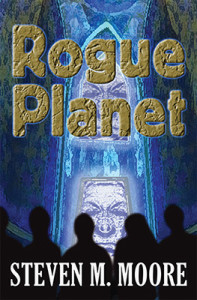 What remains mostly hidden in the novel is that this romantic sci-fi thriller is also a bridge book…even though no series follows! There are hints in the interlude section where Prince Kaushel travels to ITUIP’s capital world looking for help for the revellion. (ITUIP = “Interstellar Trade Union of Independent Planets,” created in the “Chaos Chronicles Trilogy,” and the prince’s planet is beyond its boundaries in near-Earth galactic space.) ITUIP doesn’t want to get involved, so the prince and his friends must go it alone.
What remains mostly hidden in the novel is that this romantic sci-fi thriller is also a bridge book…even though no series follows! There are hints in the interlude section where Prince Kaushel travels to ITUIP’s capital world looking for help for the revellion. (ITUIP = “Interstellar Trade Union of Independent Planets,” created in the “Chaos Chronicles Trilogy,” and the prince’s planet is beyond its boundaries in near-Earth galactic space.) ITUIP doesn’t want to get involved, so the prince and his friends must go it alone.
You will find most of the Dr. Carlos stories collected in “Dr. Carlos Obregon, Chief Medical Officer,” a free collection you can download. (See the entire list on the “Free Stuff & Contests” web page.) Rogue Planet is a bridge to those stories. Read the novel and Dr. Carlos stories to find out why.
Rogue Planet is also a bow to the “Chaos Chronicles” trilogy and Isaac Asimov. If you’re at all familiar with that great sci-fi storyteller’s oeuvre, you’ll see why as you finish Rogue Planet. But, more than anything else, Rogue Planet offers evidence that fantastic adventures do not require dungeons and dragons, which is why I rarely read fantasy!
***
Comments are welcome. (Please follow the rules on the “Join the Conversation” web page.)
Rogue Planet. My “Game of Thrones”-like romantic hard sci-fi thriller’s principal character is a bit of a rogue himself, the legal heir to a throne on a planet taken over by an evil theocracy (modelled after Iran, of course). Readers who like fantasy will probably like this novel as much as hard sci-fi addicts do. Available wherever fine sci-fi stories are sold…in both ebook and trade paperback formats! Enjoy! (Fair warning: For some reason, B&N doesn’t sell the trade paperback version, so I swallowed my pride and just linked to Amazon, which does. Because B&N used to sell the trade paperback, I imagine you can order it there at the store. Ah, the wonderful vagaries of book publishing!)
Around the world and to the stars! In libris libertas!
